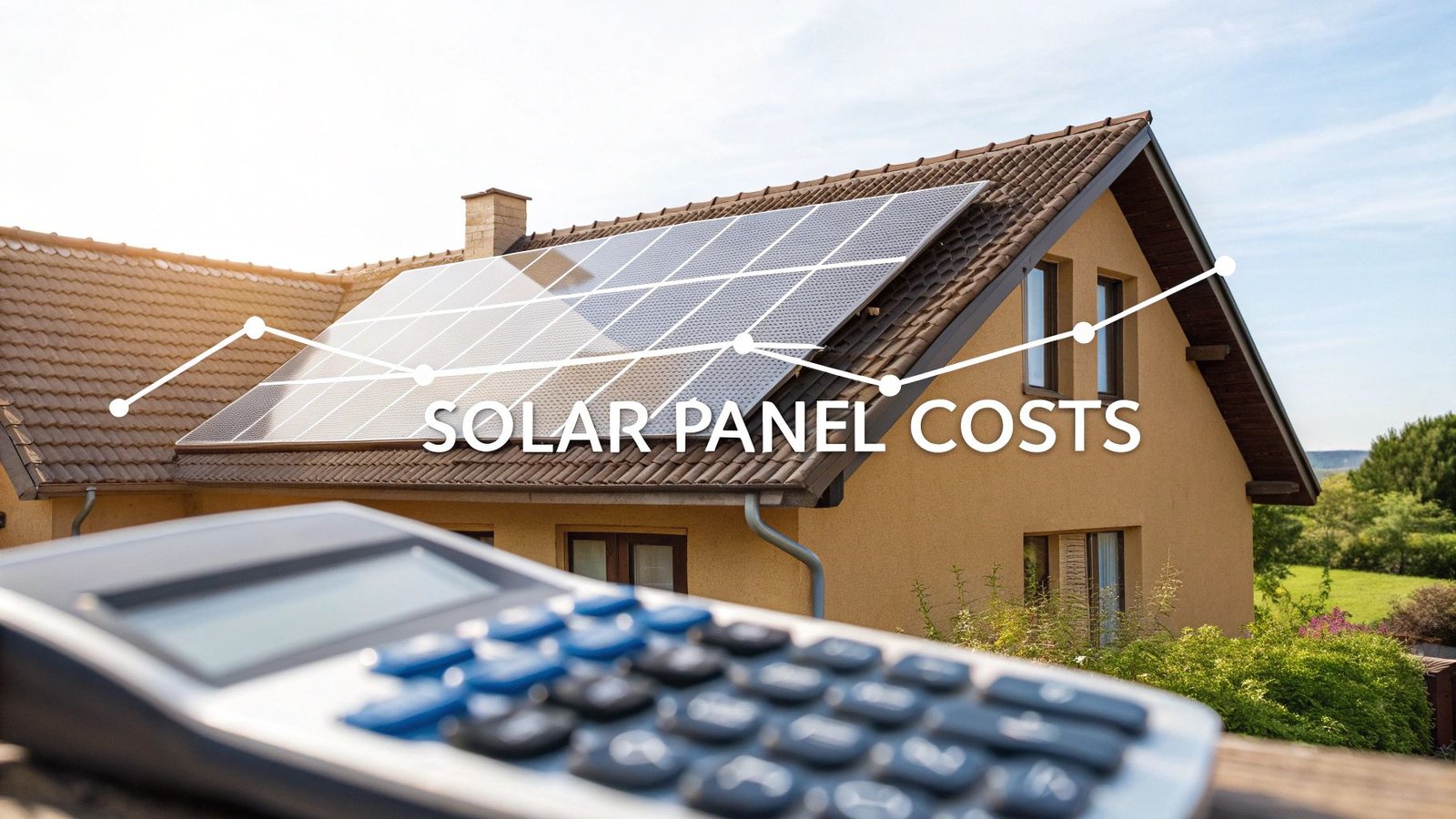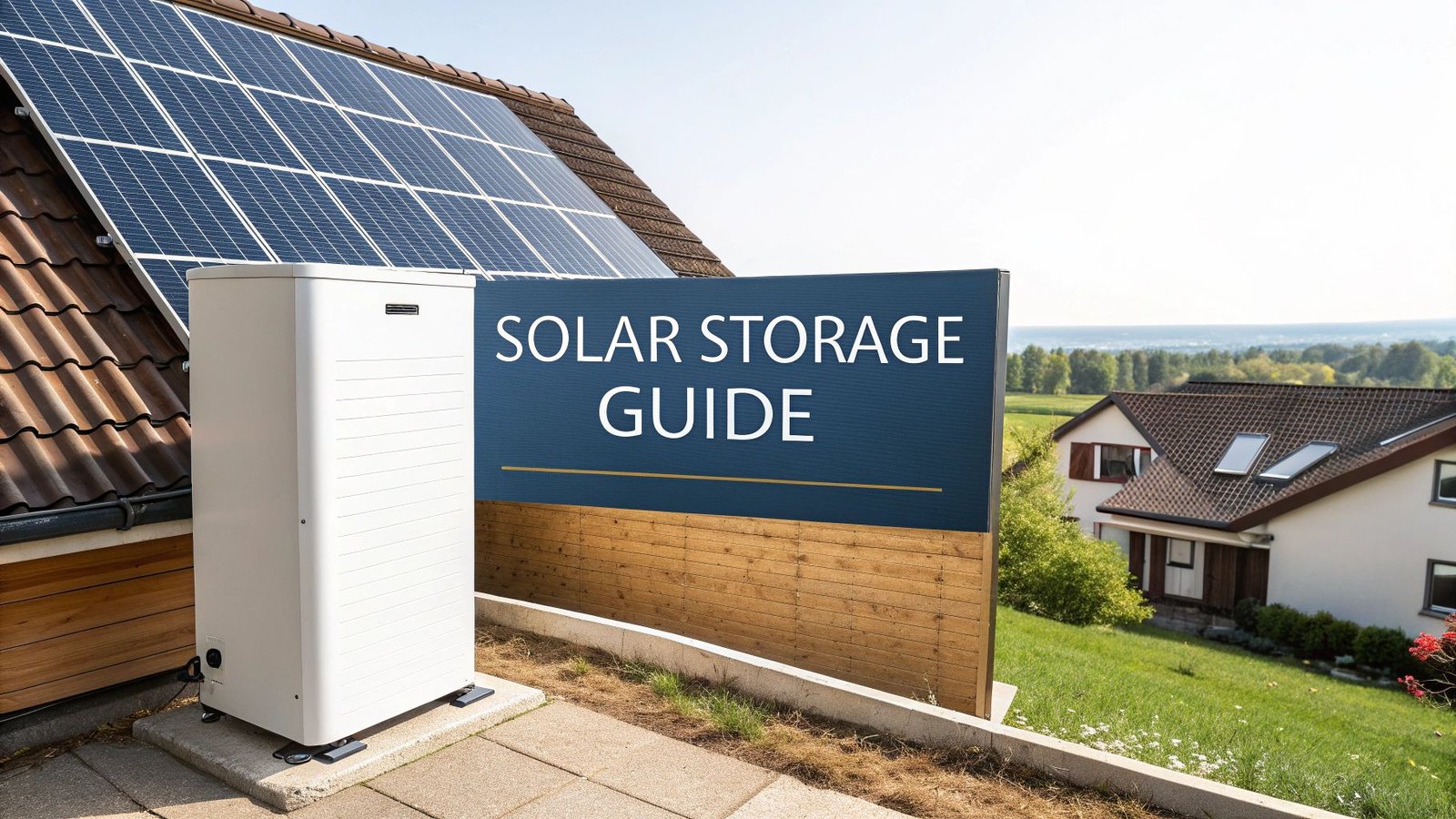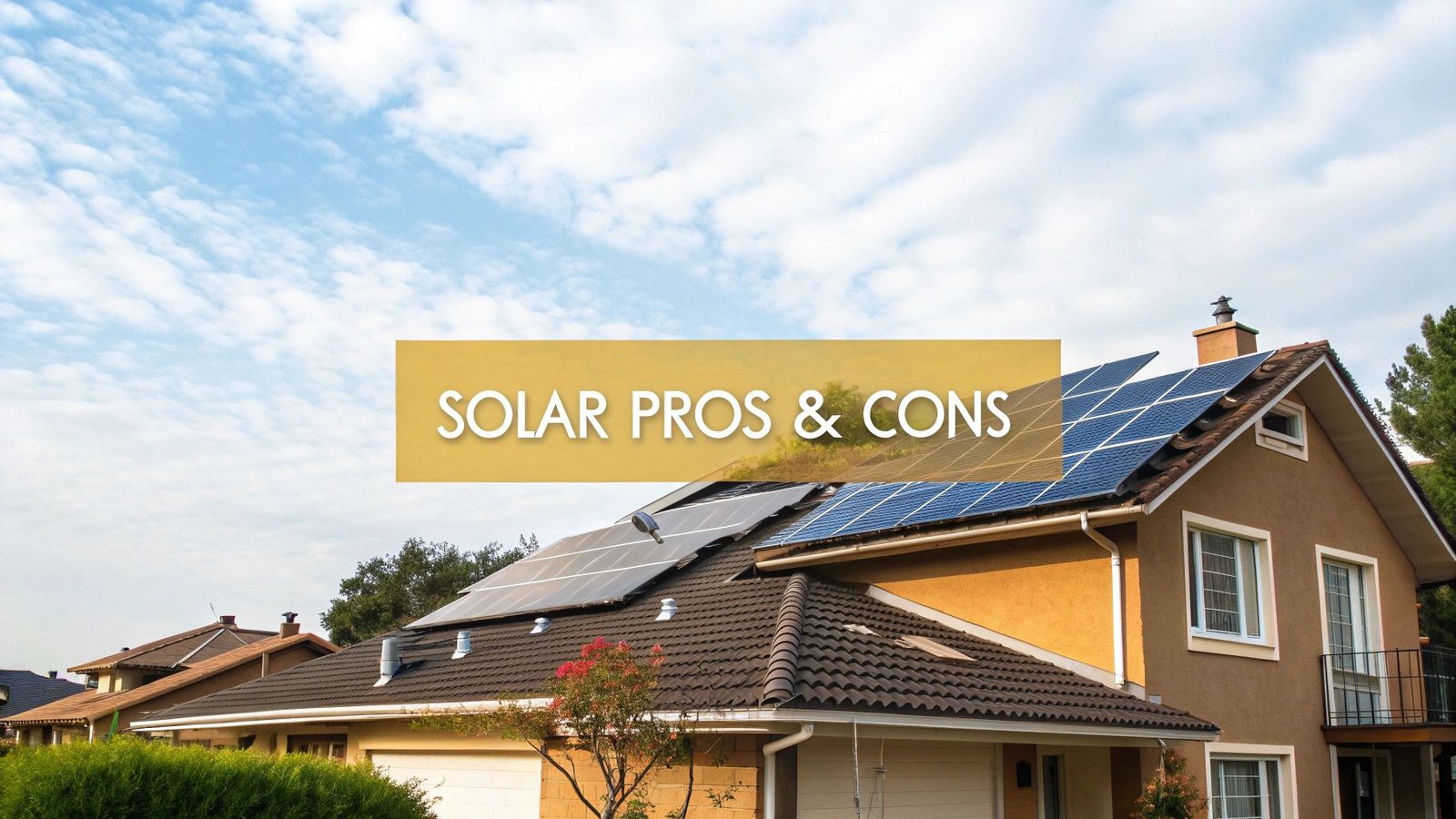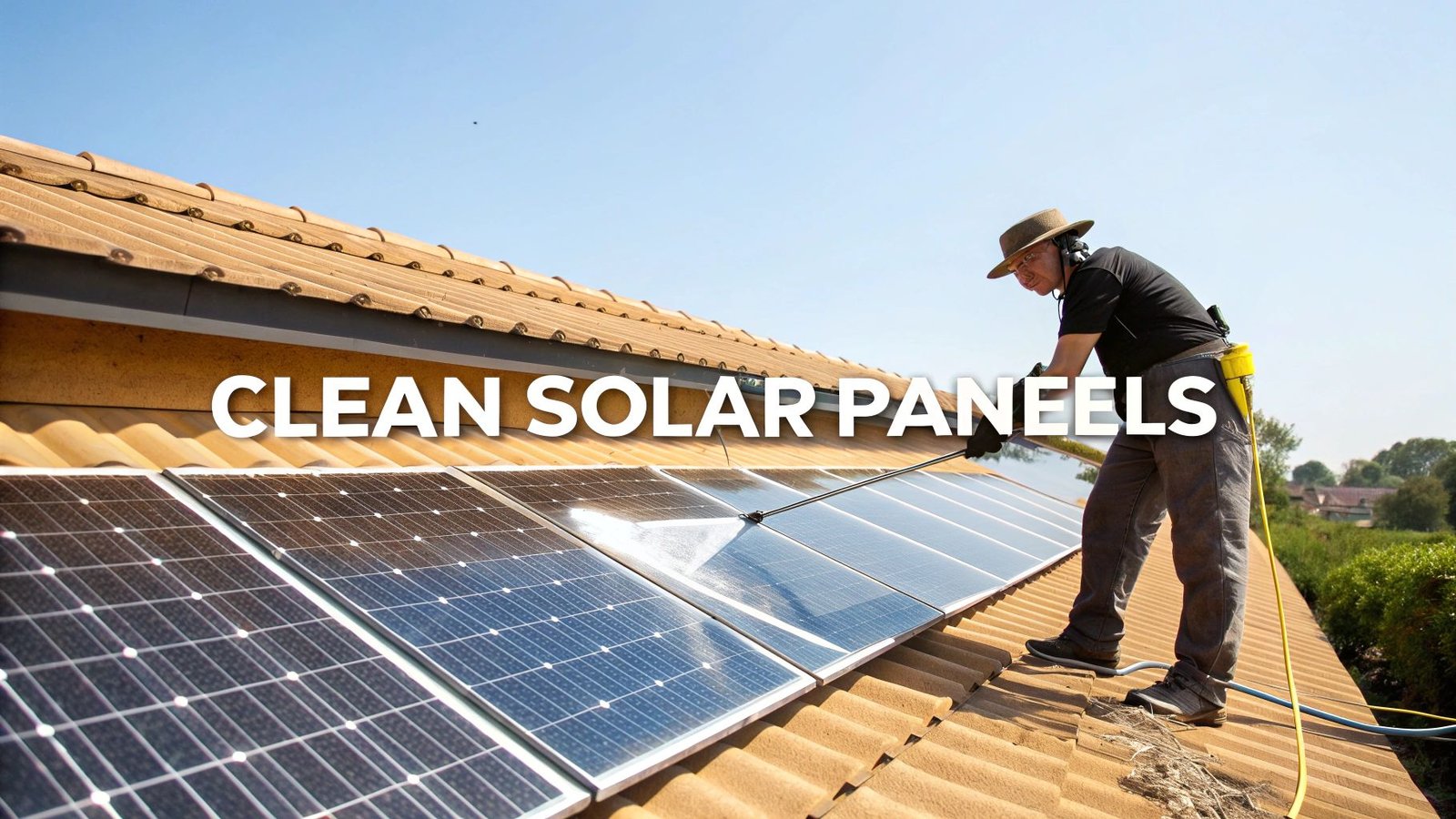When homeowners start looking into clean energy, the first question on their minds is always the same: how much do solar panels actually cost?
Let's get right to it. For a professionally installed residential solar system in the U.S., you're typically looking at a range of $24.000 a $36.000 antes de you factor in any tax credits or rebates. That figure gives you a solid baseline for the initial investment, covering everything from the hardware itself to the final flip of the switch connecting you to the grid.
Your Quick Answer To Solar Panel Costs
Thinking about solar cost isn't like buying a single appliance; it's more like investing in a complete energy solution for your home. The final price tag isn't just for the panels on your roof. It’s a package deal that includes essential hardware, expert installation, and all the necessary permits and paperwork.
As of mid-2025, the average cost for a single, professionally installed solar panel lands at around $1,200. For a typical home needing 20 to 30 panels, that adds up to the $24.000 a $36.000 system price.
But here's the good news: that sticker price is rarely what you actually pay. Federal tax credits and various state and local rebates can slash that number significantly. Some local incentives can even knock off as much as $5,000. You can learn more about how solar incentives can lower your cost and make going solar much more affordable.
Estimated Solar System Costs At a Glance
To give you a clearer picture, it helps to think in terms of system size, which is measured in kilowatts (kW). It’s simple, really: a larger home with higher electricity bills will need a bigger system, and that means a higher upfront cost.
Lo más importante: While the initial price might seem steep, remember that this is the gross cost. Once you subtract financial incentives and factor in long-term energy savings, the net amount you truly pay over the system's life is dramatically lower.
To break it down even further, here's a quick summary of what you can expect to pay based on common residential system sizes. This chart offers a straightforward look at the potential costs before any credits or rebates come into play.
gráfico TD
subgráfico Costes estimados del sistema solar (antes de incentivos)
Sistema A[5 kW<br>$15,000 - $22,000]
B[Sistema de 7 kW<br>$21,000 - $28,000]
C[Sistema de 10 kW<br>$28.000 - $38.000]
D[Sistema de 12 kW<br>$34,000 - $45,000]
fin
estilo A relleno:#4CAF50,trazo:#333,ancho trazo:2px,color:#fff
estilo B fill:#8BC34A,stroke:#333,stroke-width:2px,color:#fff
estilo C fill:#CDDC39,stroke:#333,stroke-width:2px,color:#333
estilo D fill:#FFEB3B,stroke:#333,stroke-width:2px,color:#333
These ranges give you a solid starting point for budgeting and help you match your home's energy needs to a potential system size and cost.
What Really Drives the Price of Solar Panels

Figuring out how much solar panels cost isn't like picking a TV off the shelf with a set price tag. It’s a lot more like building a custom home. The final number is a sum of many different parts, all tailored specifically to your house, your energy needs, and even your roof's unique shape.
From the specific panels you choose to the hardware that makes it all work and the professionals who put it together, every piece has a role to play in the final investment.
Core Equipment: The Panels, Inverter, and Racking
While the solar panels are the most obvious part of the system, the components working behind the scenes are just as crucial to the bottom line.
- Panel Type and Efficiency: This is a bit like choosing between regular and premium gas for your car. High-efficiency paneles monocristalinos will cost you more upfront, but they squeeze more power out of a smaller area—perfect for homes with limited roof space. On the other hand, paneles policristalinos are easier on the wallet but need more room to produce the same amount of energy.
- Inverter Technology: Think of the inverter as your system's brain. It takes the DC power your panels create and converts it into the AC power that runs everything in your house. A standard string inverter is a common, cost-effective choice. However, if your roof gets a lot of shade, you might need microinverters o optimizadores de potencia, which cost more but ensure one shady panel doesn't drag down the whole system's performance.
- Mounting and Racking: This is the strong skeleton that secures the entire system to your roof. The cost can change depending on your roof material—asphalt shingles, tile, and metal all require different hardware—and whether a standard setup will work or if a custom solution is needed.
Installation Complexity and Labor
Getting the system physically installed is a major part of the overall cost, often accounting for 25-30% of the total price. This goes far beyond just bolting panels to your roof. It involves complex electrical work, navigating local permits, and passing inspections.
A complicated roof with lots of angles, a steep pitch, or tricky materials like slate is going to require more time, specialized equipment, and highly skilled labor. Naturally, this will bump up the installation cost.
The current state of your home matters, too. If your main electrical panel is old, it might need to be upgraded to handle the new power flowing in from the sun. Similarly, an older roof may need repairs or a full replacement before it’s ready to support a solar array for the next 25 years. These are critical details to iron out with your installer.
In the end, the total price is a direct reflection of the quality of the equipment and the expertise of the installation team. Every decision, from the brand of panel to the experience of your installer, helps shape the final answer to the question, "how much do solar panels cost?" for your specific home.
Calculating Your Solar Return On Investment

Figuring out the upfront cost of solar panels is just the starting point. The real magic happens when you look past the initial price tag and focus on what you gain over the long haul. This is your return on investment (ROI), and it’s the key to understanding how a solar system becomes a powerful financial asset for your home.
Thinking of solar panels as just another home expense is a bit like buying a delivery truck and only complaining about the purchase price, completely ignoring the income it's about to generate. A better way to see it? Your solar system is a mini power plant on your roof that starts paying you back from day one.
Your Solar Payback Period Explained
The single most important number for understanding your ROI is the solar payback period. Simply put, this is how long it takes for the money you save on electricity bills to completely pay off the system's initial cost.
Once you hit that breakeven point, every bit of energy your panels produce is pure savings in your pocket.
Thanks to dramatic cost reductions, this payback period is shorter than ever. Globally, solar panel prices have plummeted by over 60% since 2015. The cost of battery storage has also dropped by a staggering 72% in that same period. With U.S. homeowners saving an average of $1,500 per year, the typical payback period now sits comfortably between 6 to 8 years.
gantt
title Solar System Payback Period Example
dateFormat YYYY-MM-DD
axisFormat %Y
section Initial Investment
Investment Cost :crit, 2025-01-01, 2025-01-02
section Savings Payback
Year 1-2 Savings :done, 2025-01-02, 2y
Year 3-4 Savings :done, after Year 1-2 Savings, 2y
Year 5-6 Savings :done, after Year 3-4 Savings, 2y
Year 7-8 Savings :active, after Year 5-6 Savings, 2y
section Pure Profit
Years 9-25+ : 2033-01-02, 17y
Estimating Monthly Savings And Long-Term Gains
So, how do you figure out what you might save? It all starts with your current electricity bill. Grab it and look for two things: your monthly usage in kilowatt-hours (kWh) and what your utility company charges you per kWh.
For example, if you pay an average of 16 cents per kWh and your new solar system generates 1,000 kWh in a month, you've just saved $160. To see how these savings add up over time, a general investment calculator can help you visualize how small monthly gains compound into significant wealth down the road.
Información clave: Don't forget that utility rates almost always go up, typically by 2-3% each year. When you go solar, you're essentially locking in your electricity costs. This means your savings actually increase over time as the grid gets more expensive for everyone else.
Boosting Your Home's Resale Value
On top of the monthly savings, solar panels add real, tangible value to your property. Study after study has shown that homes with solar panels not only sell for more money but they also sell faster than similar homes without them.
Think about it from a buyer's perspective. A home that comes with low, predictable energy bills is a massive selling point. That extra value isn't just a small bonus—it often makes a huge contribution to your total ROI, making the investment look even better when you eventually decide to sell.
How Incentives And Rebates Lower Your Real Cost
The sticker price you see for a solar panel system is almost never what you actually end up paying. It's best to think of that initial quote as the starting line, not the finish. A powerful mix of government incentives and local rebates can dramatically slash your final cost, making the real answer to "how much do solar panels cost?" a lot more appealing.
These financial perks exist for one reason: to encourage homeowners like you to switch to clean energy. They act like a massive discount, turning what might seem like an expensive home upgrade into a smart, manageable investment.
The Federal Solar Tax Credit
Right at the top of the savings pyramid is the Residential Clean Energy Credit, which most people just call the federal solar tax credit. This is the big one. It isn't just a simple deduction from your income; it's a dollar-for-dollar credit that directly reduces the federal income tax you owe.
For example, if your new solar system costs $30,000, the current 30% federal tax credit would save you $9,000 straight off your tax bill. This single incentive knocks nearly a third off your net cost, making it the most impactful financial benefit out there for homeowners going solar.
There's one catch: you have to own your solar system to qualify, not lease it. It's worth exploring the differences between solar leasing vs. PPA arrangements to see why ownership is the key to unlocking these powerful tax benefits.
State And Local Incentives
While the federal credit is a nationwide benefit, many states, cities, and even local utility companies offer their own programs to sweeten the deal. These incentives can vary a lot depending on where you live, but they usually fall into a few common categories.
The table below breaks down the most common types of incentives you might come across.
| Tipo de incentivo | How It Works | Typical Value |
|---|---|---|
| Cash Rebates | A direct, upfront cash payment to you after installation, often based on your system's size. | Varies by state; can be several thousand dollars. |
| Performance-Based Incentives (PBIs) | Payments based on the actual amount of electricity your system generates and sends to the grid. | Paid per kilowatt-hour (kWh); value depends on system production. |
| Property Tax Exemptions | Your property tax assessment won't increase, even though the solar panels add value to your home. | Saves you hundreds or thousands annually on property taxes. |
| Sales Tax Exemptions | You don't have to pay sales tax on the purchase of your solar equipment. | Can save you 4-10% on the total equipment cost, depending on your state. |
As you can see, stacking these local perks on top of the federal tax credit is how you truly maximize your savings. It's always a good idea to stay informed about government programs and be aware of any expiring solar tax credits that might affect your timeline.
This graphic breaks down where your money typically goes in a solar installation, with the physical equipment itself being the largest chunk of the expense.

Understanding this cost distribution really helps you appreciate how incentives that apply to the total system price end up providing such significant savings across the board.
Smart Ways To Finance Your Solar System

Thinking you need a huge pile of cash sitting around to go solar? That’s a common misconception. The reality is that modern financing has made solar accessible for almost any budget by spreading the cost out over time.
You’ve got three main paths to consider: a solar loan, a solar lease, or a Power Purchase Agreement (PPA). The route you choose really comes down to who owns the panels and how you prefer to save money.
- Solar Loan: This is straightforward—you borrow money to buy your system outright. You own it, you get the tax credits, and you build equity in your home.
- Solar Lease: Think of this like renting the equipment. You get the benefits of solar power with little to no money down, but you make a flat monthly payment to the solar company.
- PPA: Here, you don't pay for the panels, you just pay for the power they produce. It's usually at a lower rate than what your utility company charges, and the solar provider handles all the hardware.
Comparing Solar Loans, Leases, And PPAs
With a solar loan, you have full ownership from day one. This is a huge deal because it means you're the one who gets to claim the valuable Crédito fiscal federal 30% and any other state or local rebates available.
On the other hand, a solar lease takes all the maintenance worries off your plate. The installer owns the array, and you just pay a predictable monthly fee for the energy. The downside is you won't see any of those juicy tax incentives.
PPAs are all about buying cheaper energy. You skip the installation costs entirely but also miss out on the long-term financial perks of ownership. Your savings are tied directly to how much power the panels generate each month.
"Choosing the right financing path can cut your net cost by thousands and lock in long-term savings."
Let's break it down side-by-side:
graph TD
subgraph Solar Financing Comparison
A[Solar Loan] --> B(Ownership: You);
A --> C(Upfront Cost: Low/None);
A --> D(Incentives: Yes);
A --> E(Payment: Fixed Monthly);
F[Solar Lease] --> G(Ownership: Provider);
F --> H(Upfront Cost: Low/None);
F --> I(Incentives: No);
F --> J(Payment: Fixed Monthly);
K[PPA] --> L(Ownership: Provider);
K --> M(Upfront Cost: None);
K --> N(Incentives: No);
K --> O(Payment: Per kWh);
end
style A fill:#0277bd,stroke:#333,stroke-width:2px,color:#fff
style F fill:#5e35b1,stroke:#333,stroke-width:2px,color:#fff
style K fill:#d81b60,stroke:#333,stroke-width:2px,color:#fff
Choosing The Right Option For You
So, which one is best? If you're looking for the biggest return on your investment and the pride of ownership, a solar loan is almost always the winner. It allows you to significantly lower the net system cost through tax credits and rebates.
For those who prefer a completely hands-off approach with predictable budgeting, a lease simplifies things but puts a ceiling on your potential savings. A PPA is a great fit if you want to avoid any responsibility for the equipment and just want to pay less for electricity on a pay-as-you-go basis.
As you weigh your decision, it's also smart to look into broader home improvement financing options, as these can sometimes offer competitive rates or different terms that might work better for your situation.
Keep these tips in mind to make a smart choice:
- Always check your credit score and carefully review any loan terms offered.
- Run the numbers—compare the interest rates you're quoted against your projected energy savings.
- Don't forget to factor in the tax incentives you'll get if you own the panels. It's a significant part of the equation!
Making sure you have the right hardware to go with your financing is just as important. You can learn more in our guide on how to choose solar panels.
With the right financial plan in place, the intimidating upfront price tag becomes a manageable monthly payment that eventually pays for itself. The best first step is to talk to a few different lenders and installers to see what they can offer.
Why Solar Is Getting Cheaper Every Year
It’s truly remarkable how quickly solar panels have gone from a fringe technology to a mainstream home upgrade. Just a decade ago, the price tag put solar out of reach for most people. Today, that story has flipped entirely, thanks to huge advancements in technology and fierce competition around the world.
Think about it like flat-screen TVs. The first ones were incredibly expensive and clunky. But as manufacturing got smarter and more companies jumped in, prices plummeted while the screens got thinner and better. Solar has followed that exact same curve, getting more powerful and less expensive with each passing year.
This consistent drop in price means the answer to "how much do solar panels cost?" is always getting better for homeowners. It’s a great time to be looking into it.
The Global Solar Boom
The massive scale of solar adoption across the globe is what’s really driving down the cost for you, the homeowner. When demand skyrockets, manufacturers churn out panels in enormous volumes. This is a classic case of economies of scale—the more you make of something, the cheaper it is to produce each one.
xychart-beta
title "Global Solar PV Capacity Growth (Terawatts)"
x-axis [2022, 2023, 2024, 2025]
y-axis "Capacity (TW)" [1.2, 1.6, 2.2, 2.8]
bar [1.2, 1.6, 2.2, 2.8]
This isn't a small trend; it's a full-blown energy revolution. The total installed global PV capacity flew past 2,2 teravatios (TW) at the end of 2024, which is a huge leap from 1.6 TW the year before. In 2024 alone, the world added over 600 gigavatios (GW) of new solar, and China was responsible for nearly 60% of that growth.
This frantic pace of production has actually led to an oversupply in the market, pushing panel prices down even further for consumers. You can dive deeper into these trends and discover more insights about the global PV market in this detailed report.
This isn't just a home upgrade; it's about joining a massive global energy shift at a time when it’s more affordable than ever.
So, what's really behind this price drop? It boils down to a few key things:
- Smarter Manufacturing: Highly automated factories can build panels faster, with fewer defects, and at a lower cost.
- Better Efficiency: Today's panels squeeze more electricity out of the same amount of sunlight. That means you need fewer of them on your roof to get the job done.
- Fierce Competition: With so many companies in the game, everyone is fighting to offer the best product for the best price.
Put it all together, and you get more powerful and reliable technology for your money than ever before. It makes the financial side of going solar look better every day.
Alright, let's tackle those nagging questions that pop up even after you've run the numbers. It's totally normal to have a few "what ifs" floating around. Here, we'll get straight to the point on the most common concerns homeowners have about going solar.
Is It Cheaper to Buy Solar Panels Now or Wait?
This is the big one, isn't it? It's the classic dilemma you face with any technology that gets better and cheaper over time. Yes, solar panel prices have plummeted over the last decade, and that trend will likely continue to some degree.
But here’s the other side of that coin: the best financial incentives won't be around forever. The big one, the Crédito fiscal federal 30%, is already set to phase down in the coming years. If you wait for panels to get a little cheaper, you could easily miss out on a tax credit worth thousands of dollars. The math just doesn't work out.
Most experts in the field will tell you that we're in a sweet spot right now. The combination of affordable panels and powerful incentives makes today one of the best times ever to invest in solar.
The real question isn't just about the price of the panels themselves. It's about your total, all-in cost after every single credit and rebate has been applied. And right now, that final number looks incredibly good for homeowners.
Are There Any Hidden Costs I Should Know About?
A good, trustworthy solar installer will give you an itemized quote with no surprises. That said, it’s always smart to be aware of potential expenses that might fall outside a standard installation package.
Think of these as "pre-installation" costs that depend on the condition of your home:
- Roof Repairs: If your roof is old or in rough shape, you absolutely need to fix it antes de panels go on top. Tearing panels off to re-roof later is an expensive headache.
- Electrical Panel Upgrades: Some older homes have electrical panels that just can't handle the extra power a solar system generates. An upgrade might be necessary to keep everything safe and up to code.
- Tree Trimming: Solar panels love sunlight. If you have large trees casting shadows on your roof all day, you might need to trim some branches to maximize your energy production.
Always, always ask for a complete cost breakdown. A simple question like, "Are there any other potential costs I should be aware of?" can save you a lot of trouble down the line.
How Long Do Solar Panels Last and What Is the Upkeep?
You'll be happy to hear that modern solar panels are built like tanks and are incredibly low-maintenance. Most high-quality panels come with a 25-year performance warranty, but they’re engineered to keep producing power for 30 years or even longer. They just sit up there and do their job through all kinds of weather.
As for upkeep, it's about as simple as it gets. A good cleaning once a year to wash off any accumulated dust, pollen, or grime is usually all they need to stay in peak condition. Your installer can give you the best advice based on your local climate.
Ready to see what solar could save you? The team at Energía radiante can provide a free, no-obligation quote tailored to your home's unique needs. Get your personalized solar estimate today!




